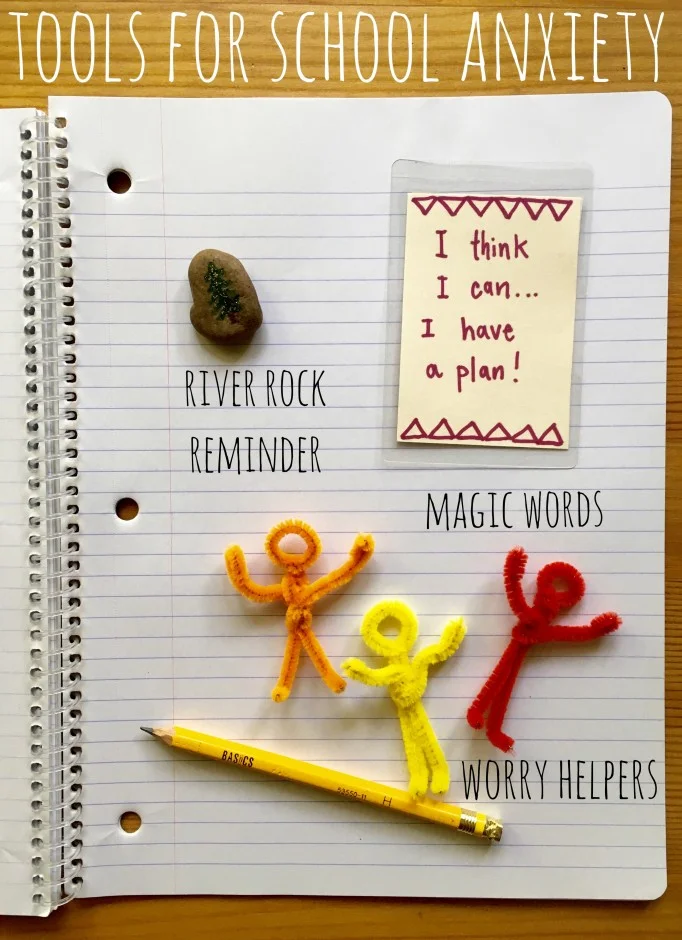While the art therapy process allows clients and therapists to create unique and individualized solutions, today we’re sharing some general creative strategies for managing back to school anxiety. First there are three basic tips for parents, followed by three arts-based tools to make together that will equip students for the first day of school.
Managing School Anxiety: Tips for Parents
- Normalize your child’s feelings of anxiety. Let them know that everyone feels nervous when starting something new. Normalizing anxiety validates your child’s experience and makes it feel less scary. If you feel comfortable, share about how you felt when starting school as a child. As you share your own experiences of anxiety, encourage your child to share what it is specifically that is making them feel anxious. Listen to their worries and validate their feelings. For listening tips that will empower your kids to share their feelings, check out our previous blog post here: Listening tips to build healthy relationships - Art as Therapy
- Dispel the mystery. Anxiety is fuelled by fears surrounding the unknown, so a great way to manage anxiety is by eliminating as many unknowns as possible. If your child will be attending a new school, go check it out together. Sit on the playground and talk through the schedule for the first day. See if you can meet your child’s teacher. Practice the walk to school, or drive the bus route together. Help your child to know what to expect. Find out as much information as you can and help your child to know what to expect.
- Be a problem solving coach. When your child shares their worries with you, try to resist reassuring them that everything will be okay. Instead, coach them through problem solving with each worry. Find out what the worst case scenario is in the child’s mind, and then work together to figure out what they could do in that scenario. You can do this through role playing – ask your child to act as the strict teacher or the bully, and then you can model appropriate ways to respond and interpret the situation. This approach builds capacity because it teaches kids and teens how to deal with situations rather than feeling like they have to avoid them at all costs.
Managing School Anxiety: Three Arts-Based Tools
As you work with children and teens to come up with solutions to problems, consider introducing some of these arts-based tools. You can work together to make the tools, and then practice using them in imaginary situations. This way, when your child encounters a similar situation at school they will have the physical tool to remind them of the strategy, and they will know how to use it in the moment.
River Rock Reminder: Identify something that helps you to feel calm. It might be a special place, a pet, time spent with a friend, or a favourite activity. Think about how it feels when you’re doing that favourite activity, or spending time with that special person. Focus on how it feels to be calm. Find a smooth river rock and use paint or sharpies to decorate the rock with an image or symbol to remind you of that calm feeling. When you’re feeling anxious or overwhelmed, plant your feet firmly on the ground and hold the smooth rock in your hand. Take a deep breath and remember the calming thoughts and sensations that your special symbol represents. Focus on these calm feelings until you begin to feel calmer in the moment. If you are anxious about going outside for recess or giving a presentation, slip the special rock into your pocket. Whenever you feel it there in your pocket, it can remind you of your calm safe place and help you to feel grounded.
Magic Words: You can change the way you think and feel by changing the words you say to yourself. If you consistently replace an anxious thought with a positive statement, it’s like reprogramming your mind with new software. It takes time, but with practice, positive affirmations can help you to overcome anxiety, and feel strong and calm in any situation. Brainstorm positive affirmations or “magic words” that will help you when feeling anxious about school. Write your positive affirmation on a card and decorate it. Read your magic words to yourself every day so that they have time to sink in. Then when you’re in a situation that makes you feel anxious, you can help yourself through it by saying the magic words in your head.
Examples of positive affirmations:
- I’m taking my time – that’s fine!
- I am unique and valuable.
- I am brave.
- I can do hard things.
- I am doing my best and so are you.
- I think I can, I have a plan.
- I’ve conquered this fear before.
- This feeling will pass.
- I’ve got the power!
Worry Helpers: Anxious thoughts can be distracting and overwhelming. When there is nothing to be done about a worry, sometimes the best solution is to take a break from it. Use pipe cleaners to create little figures or creatures who can be your worry helpers. Whenever you’re ready to take a break from a particular worry, assign that worry to one of your worry helpers. Allow the helper to hold it for you – you can tuck the worry helper away in a drawer or zip it up safe inside a pencil case. Now that the worry helper is holding the worry, you don’t have to think about it anymore. You can go out for recess or take some time to focus on your school work. Later on, you can take the worries back when you’re ready, or you can let the worry helpers keep them.
With these tips and tools, you can use the back to school butterflies as an opportunity to have fun and experience connection with your child. Let us know how it goes – we would love to see what you come up with and hear how you use these tools. If you feel that your child would benefit from more individualized support in managing anxiety, Art as Therapy can help. Send us an email at info@artastherapy.ca or call 1-519-307-9000 today.
Written by Rubi Garyfalakis, Art Therapist at Art as Therapy
References
5 Simple tips to support a child with back to school anxiety
Listening tips to build healthy relationships - Art as Therapy


